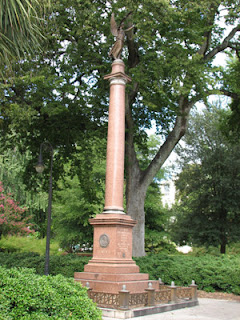We
interrupt our regular programming with this special message! According to the last Reflections post, I was
supposed to have the Conservation Corner followed by the latest Chapter
Clips. As you can see, I made some
adjustments. You will soon learn the
reason for this change. Sometimes,
something unexpected and wonderful occurs.
During Constitution Week, this happened.
As soon as I received word of this special situation, I made
adjustments. You will now learn why I
posted the Chapter Clips about the first NSDAR chapter as it “segways”
beautifully into this special edition.
Talk about Divine intervention!
During
Constitution Week, I received an e-mail from Susan Saunders with the subject line
reading: DAR Strange Happening. Just the
subject made me curious, and then the content of the e-mail evoked an array of
emotions. I felt this “strange happening”
was something that needed to be shared with you; therefore, I asked Susan to write
an article of the event for the blog. Here
is the story as she wrote it.
Historic
DAR Certificate Returns Home…
On September 17, 2013
Sumter’s Home Chapter held a Constitution Day Celebration at the Sumter
Mall. It was a fun-filled, exciting day
for all as we recognized the day our Constitution was signed with song,
Proclamations, and waving flags. To add
to the day’s exhilaration, one of the mall employees, Nancy Holmes, presented
chapter Constitution Day Chair Helen Mahon with an old, framed DAR Certificate
dated 1898. We were all aghast with
disbelief. Helen gave the treasure to
Susan Saunders, State Lineage Research Chair (and Sumter’s Home Regent) to
research.
What a thrill it was to
research this Certificate. To begin, the
beautiful Certificate had been given to Ms. Holmes by a gentleman who was at
the mall back in the mid-80’s setting up a display for the 4th of
July. Afterwards, he gave the
Certificate to her saying “Hang on to this, it might be worth something.” She held on to it for 30 years before giving
it to the chapter. That in itself is
quite a story.
After thoroughly researching
the Certificate, Susan found it to be the membership certificate of Mrs. Anna
M. Carson Dillman (DAR #22644) dated 1898.
Mrs. Dillman joined the Chicago chapter, which has a very noteworthy legacy. Chicago Chapter, NSDAR was established on
March 20, 1891, as the first chapter of the National Society Daughters of the
American Revolution. While Mrs. Dillman
was not one of its charter members, she was certainly one of their
earliest. She passed away in 1900.
Sadly,
Mrs. Dillman’s line seems to end with her.
No other DAR members have joined through her line and only six members
have joined the DAR through her Patriot James Wright. The latest joined in 1961, and none of these
ladies seem to have descendants who have joined through other Patriots. It seems that line is dead - which leads us
to the question – What do we do with this treasure?
After speaking with the
Illinois State DAR Registrar and our South Carolina DAR Curator, it has been
decided that Mrs. Dillman’s treasured DAR Membership Certificate should be
returned home to Illinois.
What
a story! It’s a shame that
no one in Mrs. Dillman’s family (no nieces, no nephews, no cousins, no one)
wanted or valued her certificate. Then,
the questions begin. How did this
certificate of a member from the Chicago Chapter of Illinois, the first chapter
in the NSDAR, end up in South Carolina?
Who was this gentleman that had this certificate? Where did he get the certificate, and why did
he have it or want it? Why did he give
the certificate to this lady? Why did
she keep it after all these years? What
made her give it to the DAR now? There are so many questions yet so few
answers. The good news is this. Just as Grace Marshall’s scrapbook had a
fairytale happy ending and is home under the protection of the SCDAR, Mrs. Dillman’s certificate will also have a fairytale
happy ending as it finds its way back home to Illinois and under the protection
of the Illinois DAR.
Even though the gentleman
will never know our appreciation, I want to thank him for seeing the value of
the certificate and keeping the certificate safe. Thank you to Ms. Holmes who
held on to it for those many years. Thank
you to Susan Saunders for understanding the treasure she had been given, for
searching so diligently for Mrs. Dillman’s family in the hopes the certificate
could be returned to them, and then contacting the ILDAR State Registrar to
ensure its preservation. Thank you to
the Illinois DAR who will take the certificate and give it a treasured home.
For those of you who follow
the blog, you know I have a challenge for you.
This is a perfect example of why the “Reflections of Our Treasured Past”
project was started, to preserve the treasures of our past and make sure they
don’t end up in the trash forever lost to the future. I cannot even begin to tell you all of the
treasures that are missing from the SCDAR for which I am desperately searching. I need your help. As you travel, as you shop, as you browse the
internet, PLEASE always be on the lookout for DAR treasures such as this
especially any from our state. As Susan
Saunders can attest, you never know what may come your way, when something may
come your way, or how it may come your way.
As President General Young in
her blog about the “Reflections” project quoted me as saying, “We cannot honor our
heritage if we haven’t preserved it. We cannot teach the future generations
without the treasures of our past. We cannot Celebrate America if we
don’t have America’s story to celebrate.”









